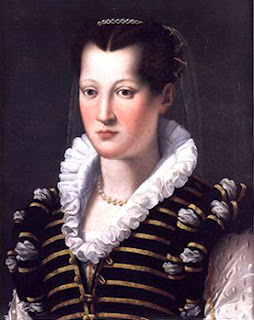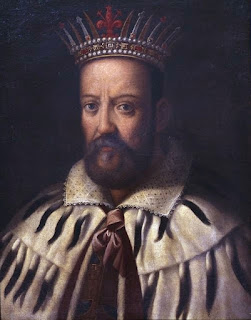Tuscan beauty killed by her husband
 |
| Isabella Romola de' Medici: a portrait painted by Alessandro Allori owned by the Uffizi Gallery |
She was said to have been beautiful, charming, educated and talented and was the favourite child of her father, Cosimo I de’ Medici.
But she died at the age of 33, believed to have been murdered by the husband her family had chosen for her to marry.
While Isabella was growing up she lived first in Palazzo Vecchio and later in Palazzo Pitti in Florence with her brothers and sisters. Her brother, Francesco, who was a year older than her, eventually succeeded his father as Grand Duke of Tuscany.
The Medici children were educated by tutors in classics, languages and the arts and Isabella particularly loved music.
When Isabella was 11 she was betrothed to 12-year-old Paolo Giordano Orsini, heir to the Duchy of Bracciano in Tuscany, because her father wanted to secure the southern border of Tuscany and his relationship with the Orsini family.
Five years later, when Isabella was 16, they were married at the Medici country estate, Villa di Castello.
 |
| The only known painting of Paolo Giordano Orsini, Isabella's husband |
After the death of her mother, Eleonora di Toledo, Isabella took on her role of first lady of Florence, showing an aptitude for politics.
She suffered several miscarriages and was childless until her late 20s when she bore Paolo a daughter in 1571 and a son in 1572.
After Paolo’s cousin, Troilo Orsini, was charged with looking after Isabella while Paolo was away on military duties, rumours began to circulate about the nature of their relationship. Troilo fled to France after being accused of murder and Isabella was summoned by her husband to join him on a hunting holiday.
She was given no choice and had to leave Florence to be with him in July 1576. Within a few days of her arrival, Isabella was found dead at the Medici villa in Cerreto Guidi. The official version was that her death happened while she was washing her hair, but the story leaked out that she was strangled by her husband in the presence of several servants.
Her death occurred just a few days after her cousin, Leonora, had died in a similar ‘accident.’ She had been married to Cosimo’s son, Pietro, and so was also Isabella’s sister in law as well as a cousin. Leonora had been part of Isabella’s circle and had followed her example in sponsoring the arts and taking a lover.
 |
| Isabella's father, Cosimo I de' Medici, who arranged for her to marry Orsini |
Most historians believe Paolo killed Isabella because she was having an affair with his cousin, Troilo, but another theory is that she died of natural causes but that enemies of the Medici family had spread rumours that she was murdered.
In order to keep in favour with the King of Spain, Francesco eventually had to admit the truth about Leonora’s death and exile his brother, Pietro.
 |
| The Palazzo Vecchio was Isabella's home as a child |
Palazzo Vecchio in Florence, where Isabella lived as a child, was built in the 14th century as a government building in Piazza della Signoria, an L-shaped square in the centre of the city where important events and public meetings were held. Isabella’s father, Cosimo I, had the interior of Palazzo Vecchio redecorated and also adopted Palazzo Pitti as another residence for his family. He had a gallery over Ponte Vecchio built to enable them to move easily from one palace to another.
 |
| An 18th century depiction of the Medici villa at the Tuscan town of Cerreto Guidi, south of Florence |
Isabella’s death occurred at a villa commissioned by Cosimo de’ Medici in Cerreto Guidi, a small town to the south of Florence. It was built around 1556 as a hunting residence and is now a UNESCO World Heritage Site along with other Medici villas. The design is attributed to Bernardo Buontalenti. The villa is in Via Ponti Medicei and now houses the Historical Museum of Hunting, which has a collection of hunting and shooting equipment dating from the 17th to the 19th century.
More reading:
An unsolved murder mystery: the death of Francesco I de' Medici
The shocking fate of Eleonora Garcia di Toledo
The banker who founded the Medici dynasty
Also on this day:
1834: The birth of Amilcare Ponchielli, opera composer
1900: The birth of Gino Lucetti, an anarchist who tried to kill Mussolini
1907: The birth of Altiero Spinelli, the man who invented the EU
Home







